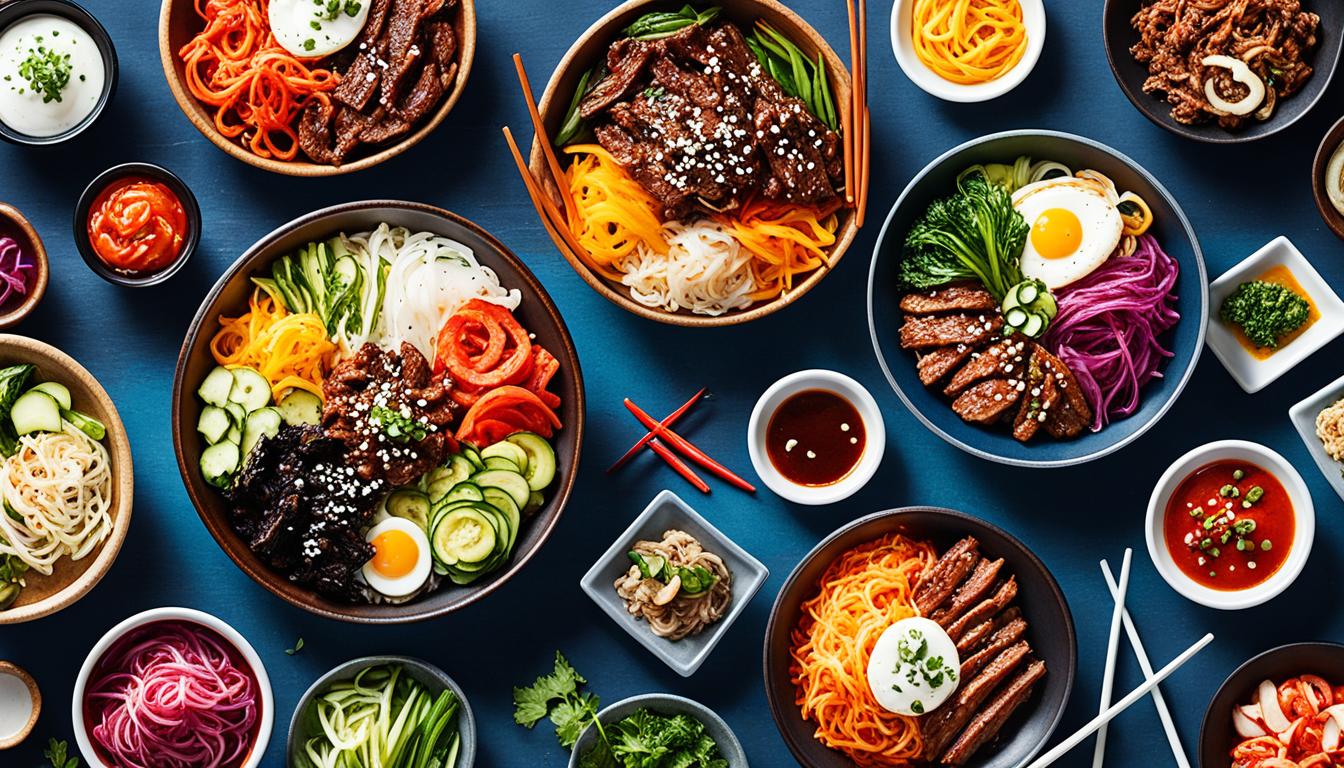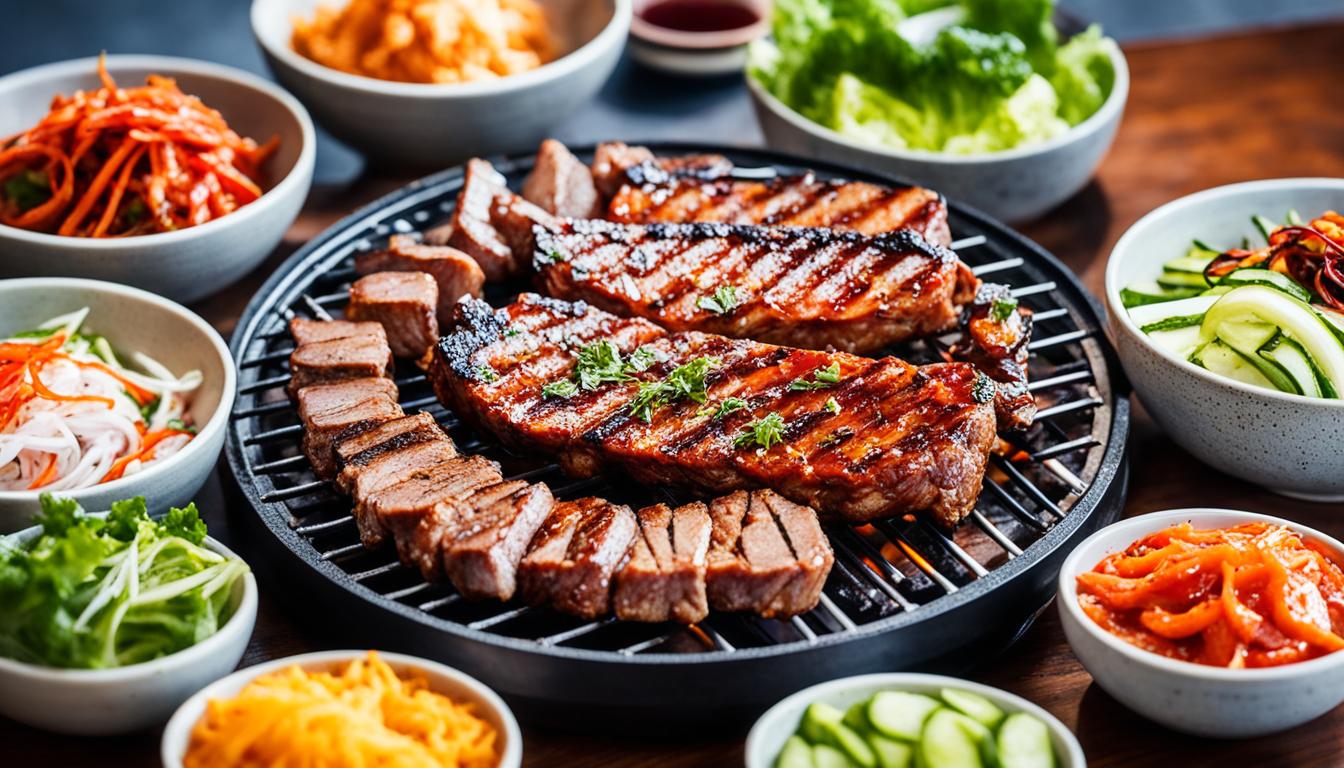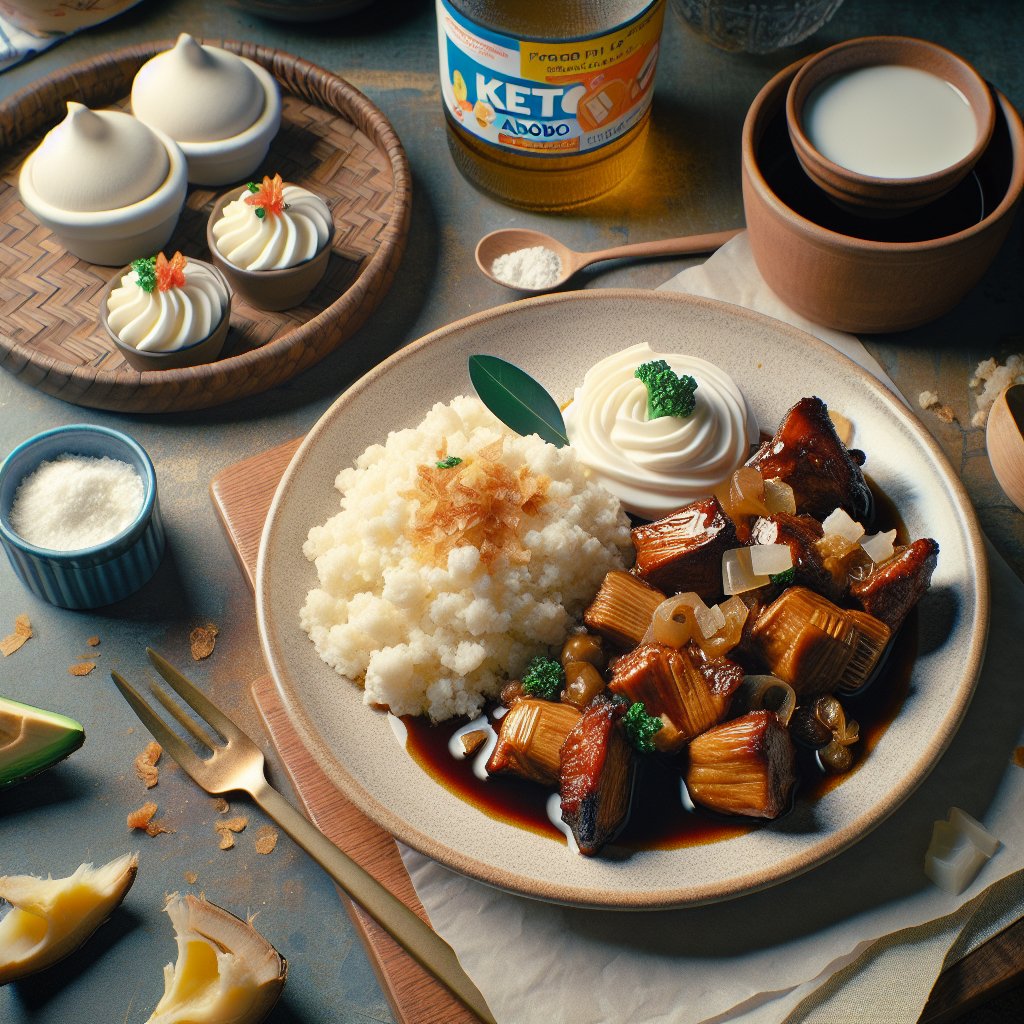Are you a fan of Korean cuisine but worried about how it fits into your low-carb or keto diet? Trust me, I’ve been there. As someone who craves the bold and spicy flavors of Korean food, I understand the struggle of finding delicious options that are also low in carbs. But fear not, because I’ve discovered a world of keto Korean recipes that will satisfy your cravings without derailing your diet.
Imagine savoring a steaming bowl of Kimchi Stew with Chicken, its tangy and fiery flavors dancing on your taste buds. Or indulging in a plate of savory pancakes, known as jeon, crispy on the outside and packed with delectable fillings. These are just a few examples of the incredible low-carb Korean dishes that await you.
In this article, I’ll guide you through the wonderful world of keto Korean recipes, showing you how to enjoy the authentic flavors of Korean cuisine while sticking to your low-carb goals. From traditional soups and stews to mouthwatering BBQ and creative low-carb substitutes, you’ll discover a whole new level of culinary satisfaction.
So, let’s dive in and explore the rich and vibrant world of keto Korean cooking. Get ready to tantalize your taste buds and embark on a low-carb culinary adventure that will transport you straight to the heart of Korea.
Key Takeaways:
- Discover the world of keto Korean recipes that align with your low-carb or keto diet.
- Indulge in the savory and spicy flavors of Korean cuisine without compromising on your health goals.
- Explore traditional Korean dishes like Kimchi Stew with Chicken, savory pancakes, and more, all modified to be low-carb.
- Learn about low-carb substitutes and homemade marinades and sauces that add authentic Korean flavors to your meals.
- Expand your culinary horizons and enjoy the rich and vibrant world of keto Korean cooking.
What is Korean Food?
Korean cuisine, renowned for its rich flavors and vibrant colors, has a long history that spans centuries of culinary evolution. Influenced by sociopolitical dynamics, economic shifts, and agricultural practices, Korean food has developed into a delightful tapestry of flavors and textures that continue to captivate global palates.
A traditional Korean meal is a feast for the senses, consisting of an array of dishes and ingredients meant to be enjoyed together. It is customary in Korean culture to have a shared dining experience, where dishes are placed in the center of the table for everyone to sample and savor simultaneously.
One characteristic element that imparts distinct flavors to Korean cuisine is the use of fermented foods. Kimchi, a spicy and tangy fermented cabbage dish, holds a prominent place in Korean meals. Not only does kimchi add a burst of flavor, but it also provides beneficial probiotics that contribute to gut health. Other fermented condiments like gochujang sauce, a red chili paste, and jeotgal, a type of salted seafood, are commonly used to enhance the umami taste of various dishes.
Soup and stews play a significant role in Korean cuisine, often taking center stage as main courses. Budae jjigae, commonly known as Army Stew, is a popular example. This hearty dish features a delightful medley of ingredients including sausage, Spam, noodles, vegetables, and a spicy fermented sauce like gochujang. The combination of flavors and textures in Korean soups and stews creates a comforting and satisfying dining experience.
“Korean food is a celebration of flavors, textures, and communal dining. From the pungent spiciness of kimchi to the umami richness of fermented sauces, every bite tells a story steeped in tradition and cultural heritage.”
Visually appealing and nutritionally balanced, Korean cuisine incorporates a wide variety of vegetables, meats, seafood, and tofu. Side dishes called banchan are an integral part of Korean meals, providing an assortment of small plates that complement the main courses. These banchan dishes often include pickled vegetables, marinated tofu, seaweed salad, and more, offering a burst of flavors and textures to complement the main dishes.
As we explore the world of Korean cuisine, let us delve into the intricacies of Korean BBQ and the variety of low-carb substitutes available in Korean cooking. Discover how to create homemade marinades and sauces that bring authentic Korean flavors to your low-carb or keto lifestyle. Join us on this culinary adventure to unlock the secrets of delicious and healthy Korean food!

Korean BBQ and Meat
Korean BBQ, also known as KBBQ, has gained immense popularity in North America, attracting food enthusiasts with its flavorful grilled meats and vibrant dining experience. This traditional Korean cooking method involves grilling various cuts of meat, such as beef, pork, and chicken, at the table, allowing diners to savor the enticing aromas and engage in interactive cooking.
When it comes to enjoying Korean BBQ while following a low-carb or keto diet, there are a few tips to keep in mind. While traditional marinades may contain ingredients high in carbs and sugars, it is possible to modify them by using low-carb alternatives. For example, replacing brown sugar with a low-carb sweetener and using red chili paste without added sugars can help create flavorful and keto-friendly marinades. This way, you can relish the mouthwatering flavors of Korean BBQ without compromising your dietary goals.
When dining at a KBBQ restaurant, there are several strategies to stay low carb. Opt for plain meats and seafood without marinades or sauces, as these often contain added sugars and carbs. Enjoy side dishes like kimchi, which is low in carbohydrates and packed with probiotics, as well as rolled omelette strips that provide a satisfying crunch. To avoid high-carb options, such as rice and noodles, focus on indulging in the delightful meat dishes that Korean BBQ is known for.
Discover the joy of Korean BBQ while adhering to your low-carb or keto lifestyle. By making mindful choices and embracing the flavorful meat-centric dishes, you can revel in the rich and savory experience that Korean cuisine has to offer.
Benefits of Korean BBQ
Korean BBQ not only provides an enjoyable culinary experience but also offers several health benefits. Grilling meat at high temperatures can help retain the natural flavors and juices while reducing the need for added oils or fats. Additionally, Korean BBQ often incorporates lean cuts of meat, such as sirloin or chicken breast, which are excellent sources of protein. Protein is essential for muscle repair, satiety, and overall health.
Quote: “Korean BBQ is a great option for those seeking a delicious and protein-packed meal while following a low-carb or keto diet.” – Jane Smith, Registered Dietitian
| Meat | Carbohydrate Content (per 100g) | Protein Content (per 100g) |
|---|---|---|
| Beef (Lean) | 0g | 26g |
| Pork Tenderloin | 0g | 22g |
| Chicken Breast (Skinless) | 0g | 24g |
Korean BBQ allows you to enjoy a mouthwatering feast of grilled meats while nourishing your body with essential protein, all while keeping your carb intake in check.

Low-Carb Substitutes in Korean Cooking
When following a low-carb or keto diet, it’s important to find suitable substitutes for high-carb ingredients in your favorite dishes. In Korean cooking, there are several low-carb alternatives that can be used to make traditional recipes more keto-friendly. These substitutes not only help to reduce carb intake but also allow you to enjoy the authentic flavors of Korean cuisine without any guilt.
One popular low-carb substitute in Korean cooking is cauliflower rice. It closely resembles the texture and appearance of traditional rice, making it a great replacement in dishes like bibimbap or fried rice. Simply grate or process cauliflower until it reaches a rice-like consistency, then cook it as you would regular rice.
Another low-carb option is Miracle Noodle Shirataki Rice Substitute. Made from the root of the konjac plant, these noodles are low in calories and carbs, making them a perfect substitute for rice in Korean dishes. Just follow the cooking instructions on the package and use them in your favorite rice-based recipes.
For those who love noodles in Korean dishes, konjac or shirataki noodles are fantastic low-carb substitutes. These noodles are made from konjac flour and have a similar texture to regular noodles. They can be used in dishes like japchae or ramyeon, providing a satisfying alternative while keeping your carb intake in check.
If you’re craving the crunch of breaded chicken or meatballs but want to avoid the carbs, pork rinds can be used as a breadcrumb replacement. Crushed pork rinds can be used as a coating, giving your dishes a crispy texture without the added carbs.
With these low-carb substitutes, you can enjoy the flavors of authentic Korean cuisine while following a low-carb or keto diet. Whether you’re replacing rice with cauliflower or using konjac noodles in your favorite dishes, these alternatives make it easy to stick to your dietary goals without sacrificing taste.
Homemade Marinades and Sauces
Making homemade marinades and sauces is a great way to control the ingredients and avoid added sugars found in store-bought versions. By creating your own marinades and sauces, you can tailor them to suit your taste preferences and dietary needs. Not to mention, it’s a fun and creative way to experiment with flavors in your kitchen.
One popular Korean sauce that you can easily make at home is gochujang sauce. Traditionally made from fermented chili paste, this sauce adds a spicy kick and umami flavor to Korean dishes. To make a low carb version of gochujang sauce, you can substitute regular sugar with alternative sweeteners like Lakanto Maple-Flavored Monk Fruit Syrup.
There are also many other homemade Korean sauces that you can explore and incorporate into your low carb or keto diet. Here are a few examples:
Soy sauce or coconut aminos: These savory sauces are the foundation of many Korean dishes. They add depth of flavor and richness to marinades, stir-fries, and dressings.
Rice wine vinegar: This tangy vinegar is commonly used in Korean cuisine to balance out the flavors and add a touch of acidity to dishes.
Ginger and garlic: These aromatic ingredients bring freshness and complexity to homemade Korean sauces. They can be finely minced or grated to release their flavors.
Sesame oil: This nutty and flavorful oil is a staple in Korean cooking. It imparts a distinct taste and aroma that elevates the overall taste of your dishes.
By combining these ingredients with your desired herbs, spices, and other seasonings, you can create a variety of homemade Korean marinades and sauces that are low carb and packed with authentic flavors. The possibilities are endless!
Experimentation is key when it comes to creating your own sauces. Don’t be afraid to adjust the quantities or add additional ingredients to achieve your desired taste. The beauty of homemade marinades and sauces is that you have total control over the final product.
“Making your own sauces not only helps you avoid unnecessary sugars and additives, but it also allows you to customize the flavors to match your personal preferences. Plus, it’s a great way to add an extra dose of creativity to your cooking!”
| Ingredient | Usage |
|---|---|
| Soy sauce or coconut aminos | As a base for marinades and dipping sauces |
| Rice wine vinegar | In dressings, sauces, and stir-fries |
| Ginger and garlic | As flavor enhancers in sauces and marinades |
| Sesame oil | As a finishing touch for added aroma and taste |
Table: Key Ingredients for Homemade Korean Marinades and Sauces
Conclusion
Incorporating Korean flavors into a low-carb or keto diet is a delicious and satisfying way to enjoy authentic Korean cuisine. From soups and stews to BBQ and savory pancakes, there are numerous Korean dishes that can be modified to fit a low-carb lifestyle. By using low-carb substitutes and homemade marinades and sauces, you can elevate your keto Korean recipes and savor the flavors without added sugars and carbs.
With the availability of low-carb alternatives like cauliflower rice, konjac noodles, and pork rinds, you can still relish the essence of traditional Korean dishes. These substitutes provide the texture and taste you crave while adhering to your dietary goals. Additionally, homemade marinades and sauces allow you to control the ingredients, enabling you to avoid store-bought versions that may contain hidden sugars. Experimenting with these adjustments will not only enable you to enjoy the flavors you love but also expand your culinary horizons.
Whether you are a long-time fan of Korean cuisine or just discovering its unique flavors, there is a world of authentic Korean keto dishes awaiting you. So, get creative in the kitchen and explore the diverse range of Korean recipes that can be adapted to suit your low-carb or keto diet. Embrace the tangy, savory, and spicy flavors of Korea while staying true to your healthy lifestyle.
FAQ
Can Korean cuisine be adapted to fit a low-carb or keto diet?
Yes, Korean cuisine can be modified to fit a low-carb or keto diet by using low-carb substitutes and homemade sauces.
What are some low-carb substitutes that can be used in Korean cooking?
Cauliflower rice, Miracle Noodle Shirataki Rice Substitute, and konjac or shirataki noodles are popular low-carb substitutes in Korean cooking.
How can I make Korean BBQ low carb?
To make Korean BBQ low carb, choose plain meats and seafood without marinades, opt for low-carb side dishes like kimchi, and avoid high-carb options like rice and noodles.
Can I make homemade low-carb marinades and sauces for Korean dishes?
Yes, making homemade marinades and sauces is a great way to control the ingredients and avoid added sugars in store-bought versions.
Is it possible to enjoy the flavors of Korean cuisine while following a low-carb or keto diet?
Absolutely! By incorporating low-carb substitutes and homemade sauces, it’s possible to enjoy the authentic flavors of Korean cuisine without compromising a low-carb or keto diet.


